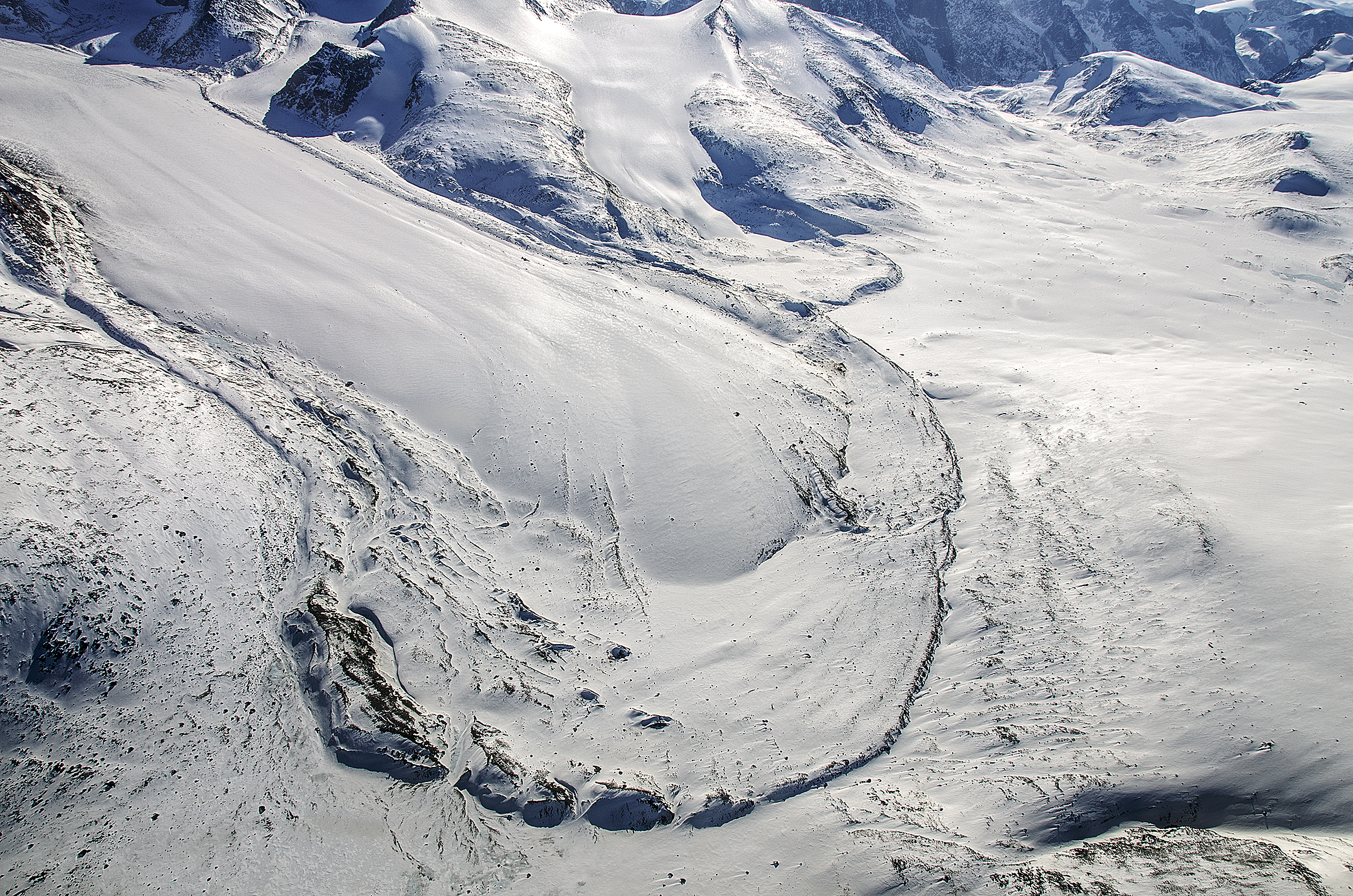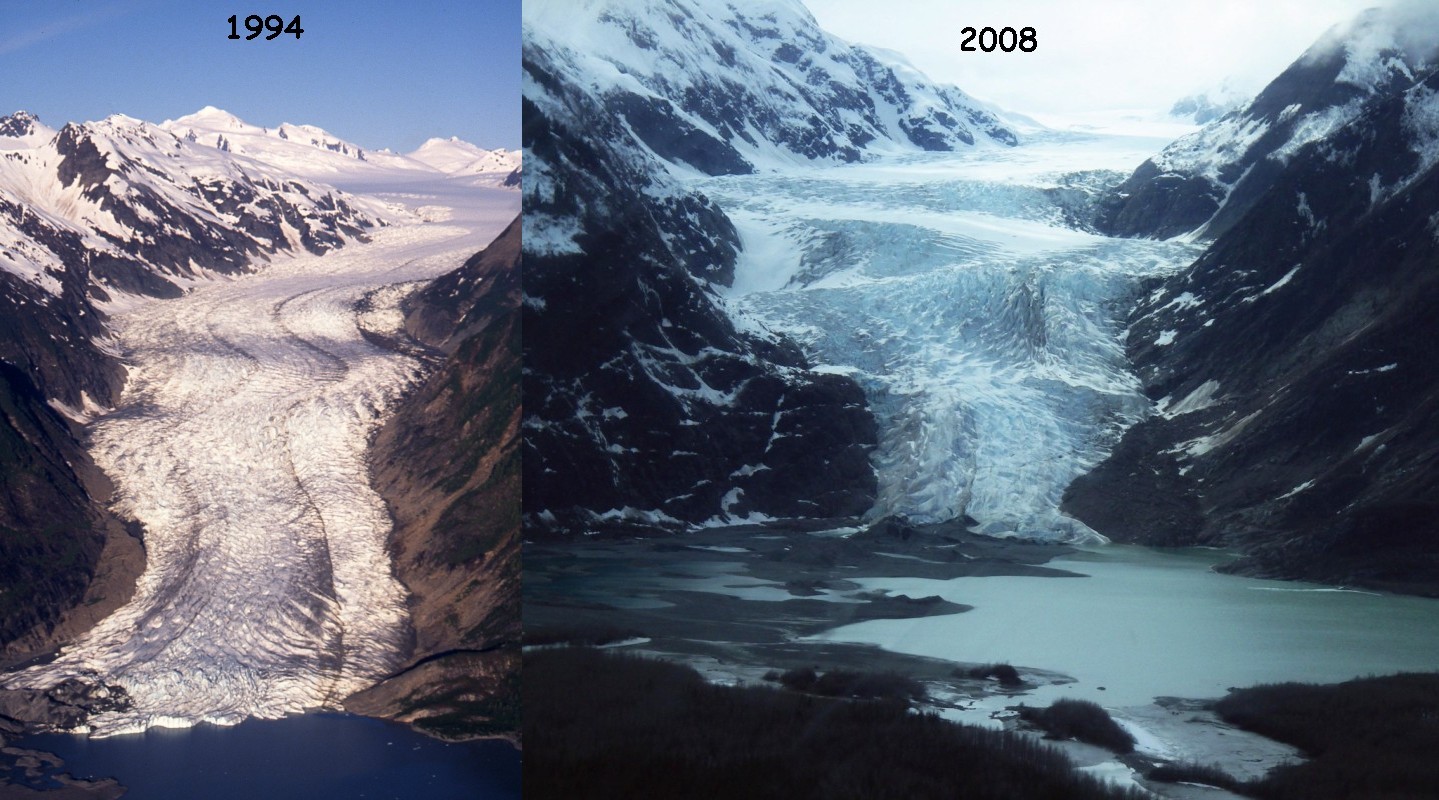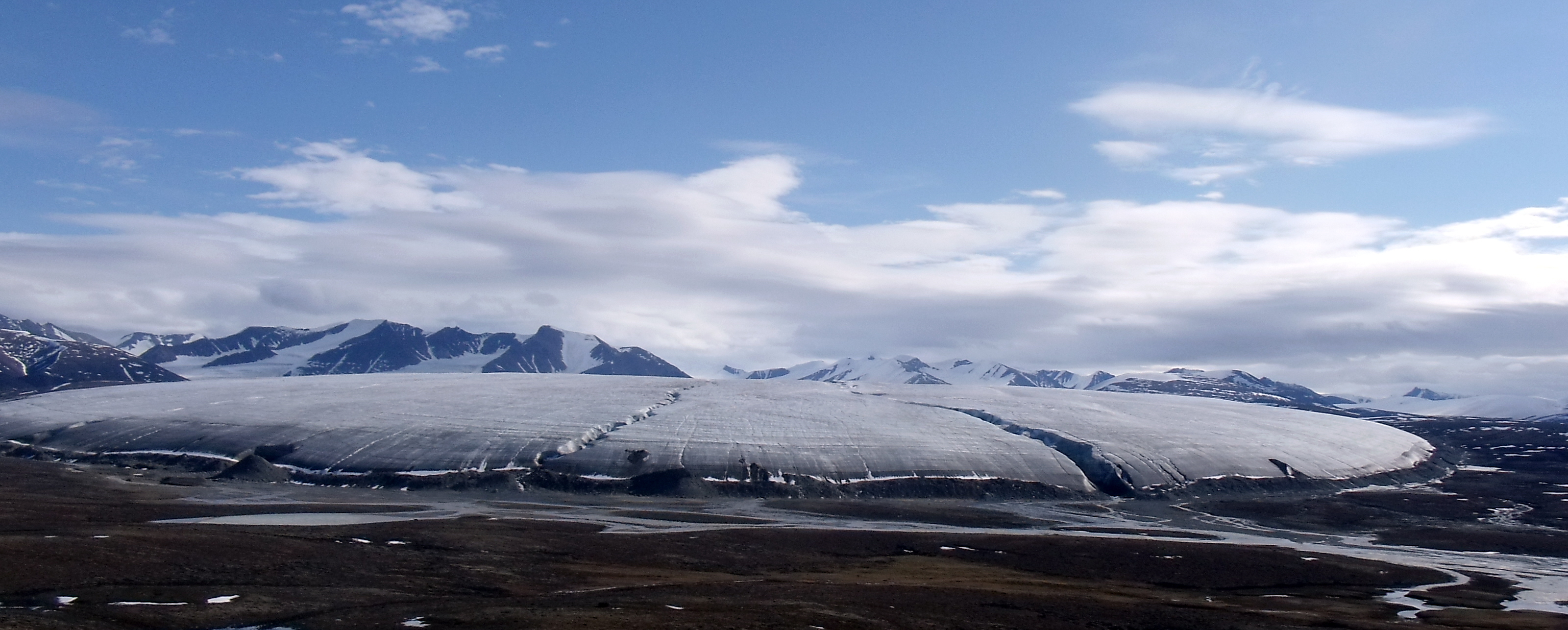terminal moraine on:
[Wikipedia]
[Google]
[Amazon]

 A terminal moraine, also called end moraine, is a type of
A terminal moraine, also called end moraine, is a type of
 As a
As a
 During glacial retreat,
During glacial retreat,


moraine
A moraine is any accumulation of unconsolidated debris ( regolith and rock), sometimes referred to as glacial till, that occurs in both currently and formerly glaciated regions, and that has been previously carried along by a glacier or ice sh ...
that forms at the terminal
Terminal may refer to:
Computing Hardware
* Terminal (electronics), a device for joining electrical circuits together
* Terminal (telecommunication), a device communicating over a line
* Computer terminal, a set of primary input and output devi ...
(edge) of a glacier
A glacier (; ) is a persistent body of dense ice that is constantly moving under its own weight. A glacier forms where the accumulation of snow exceeds its ablation over many years, often centuries. It acquires distinguishing features, such a ...
, marking its maximum advance. At this point, debris that has accumulated by plucking and abrasion, has been pushed by the front edge of the ice, is driven no further and instead is deposited in an unsorted pile of sediment. Because the glacier acts very much like a conveyor belt
A conveyor belt is the carrying medium of a belt conveyor system (often shortened to belt conveyor). A belt conveyor system is one of many types of conveyor systems. A belt conveyor system consists of two or more pulleys (sometimes referred t ...
, the longer it stays in one place, the greater the amount of material that will be deposited. The moraine is left as the marking point of the terminal extent of the ice.
Formation
 As a
As a glacier
A glacier (; ) is a persistent body of dense ice that is constantly moving under its own weight. A glacier forms where the accumulation of snow exceeds its ablation over many years, often centuries. It acquires distinguishing features, such a ...
moves along its path, the surrounding area is continuously eroding. Loose rock and pieces of bedrock
In geology, bedrock is solid rock that lies under loose material ( regolith) within the crust of Earth or another terrestrial planet.
Definition
Bedrock is the solid rock that underlies looser surface material. An exposed portion of be ...
are constantly being picked up and transported with the glacier
A glacier (; ) is a persistent body of dense ice that is constantly moving under its own weight. A glacier forms where the accumulation of snow exceeds its ablation over many years, often centuries. It acquires distinguishing features, such a ...
. Fine sediment
Sediment is a naturally occurring material that is broken down by processes of weathering and erosion, and is subsequently transported by the action of wind, water, or ice or by the force of gravity acting on the particles. For example, sand ...
and particles are also incorporated into the glacial ice. The accumulation of these rocks and sediment together form what is called glacial till
image:Geschiebemergel.JPG, Closeup of glacial till. Note that the larger grains (pebbles and gravel) in the till are completely surrounded by the matrix of finer material (silt and sand), and this characteristic, known as ''matrix support'', is d ...
when deposited.
Push moraine
A push moraine or pushed moraine is in geomorphology a moraine (a landform formed by glacial processes) that forms when the terminus advance of a lowland glacier pushes unstratified glacial sediment into a pile or linear ridge in front of it. A pus ...
s are formed when a glacier retreats from a previously deposited terminal moraine, only to push proglacial sediment or till into an existing terminal moraine. This process can make the existing terminal moraine far larger than its previous size.
Dump moraines occur when rock, sediment, and debris, which accumulate at the top surface of the glacier, either slide, fall, or flow off of the snout
A snout is the protruding portion of an animal's face, consisting of its nose, mouth, and jaw. In many animals, the structure is called a muzzle, rostrum, or proboscis. The wet furless surface around the nostrils of the nose of many mammals is ...
of the glacier. The accumulation of till will form a terminal moraine as the glacier retreats.
Ablation
Ablation ( la, ablatio – removal) is removal or destruction of something from an object by vaporization, chipping, erosive processes or by other means. Examples of ablative materials are described below, and include spacecraft material for ...
moraines form when a large piece of ice, containing an accumulation of sediment and debris, breaks from the snout of the glacial. Once it is separated and begins to melt, the debris found throughout this glacial piece is deposited to form a new terminal moraine. It is important to note that the more debris that is found within the ice, the longer it will take for complete melting to occur.
Climate
Climate is the long-term weather pattern in an area, typically averaged over 30 years. More rigorously, it is the mean and variability of meteorological variables over a time spanning from months to millions of years. Some of the meteorologi ...
plays an important role in the formation of terminal moraines. As temperatures increase, glaciers begin to retreat faster, causing more glacial till to be deposited in the form of terminal moraines. However, when temperatures decrease, zone of accumulation goes into overdrive. This starts a process where the accumulation of snow
Snow comprises individual ice crystals that grow while suspended in the atmosphere—usually within clouds—and then fall, accumulating on the ground where they undergo further changes.
It consists of frozen crystalline water throughou ...
, in the zone of accumulation is greater than loss due to melting or ablation.
History
During theLast Glacial Maximum
The Last Glacial Maximum (LGM), also referred to as the Late Glacial Maximum, was the most recent time during the Last Glacial Period that ice sheets were at their greatest extent.
Ice sheets covered much of Northern North America, Northern Eu ...
(LGM), the Northern hemisphere began its modern ice-age. Most of what is now Canada
Canada is a country in North America. Its ten provinces and three territories extend from the Atlantic Ocean to the Pacific Ocean and northward into the Arctic Ocean, covering over , making it the world's second-largest country by to ...
and northern portions of the United States
The United States of America (U.S.A. or USA), commonly known as the United States (U.S. or US) or America, is a country Continental United States, primarily located in North America. It consists of 50 U.S. state, states, a Washington, D.C., ...
were covered in ice sheets or mountain driven glaciers during the last stage of the Pleistocene Epoch
The Pleistocene ( , often referred to as the '' Ice age'') is the geological epoch that lasted from about 2,580,000 to 11,700 years ago, spanning the Earth's most recent period of repeated glaciations. Before a change was finally confirmed i ...
. In the last 400,000 years there have been roughly four major glacial events. Evidence of these separate events is found not only in ice cores
An ice core is a core sample that is typically removed from an ice sheet or a high mountain glacier. Since the ice forms from the incremental buildup of annual layers of snow, lower layers are older than upper ones, and an ice core contains i ...
, but also in the glacial till that was deposited.
Rocks and sediment not native to one area could be found in a region completely foreign to that from which they were formed. This is the result of a prior terminal moraine being picked up and deposited by a newer glacial event. The terminal moraines resulting from the Last Glacial Maximum are the most informational features about glacial advance still present today.
Effects on landscape
 During glacial retreat,
During glacial retreat, meltwater
Meltwater is water released by the melting of snow or ice, including glacial ice, tabular icebergs and ice shelves over oceans. Meltwater is often found in the ablation zone of glaciers, where the rate of snow cover is reducing. Meltwater ca ...
flows in the opposite direction of the retreat, causing braided streams and channels to form. A terminal moraine creates a barrier helping to trap water in a newly-formed glacial lake
A glacial lake is a body of water with origins from glacier activity. They are formed when a glacier erodes the land and then melts, filling the depression created by the glacier.
Formation
Near the end of the last glacial period, roughly 10, ...
. The positioning of the lake resulted from not only subsidence
Subsidence is a general term for downward vertical movement of the Earth's surface, which can be caused by both natural processes and human activities. Subsidence involves little or no horizontal movement, which distinguishes it from slope mov ...
, but also the terminal moraine providing the foundation for the wall that holds the water in place. While the terminal moraine consists of a long mound of rock and sediment which forms a structure that appears to be a barrier for water, there are still ways for the water to flow through. Water makes its way through glacial till to form streams and channels.
Another landscape feature formed by terminal moraines are kettle lakes. These are produced during glacial recession when boulders or blocks of ice are left in place as the glacier recedes from the newly deposited terminal moraine. As the ice boulders melt, they begin to pool to form kettle lakes in the glacial outwash plain.
Effects on vegetation
The terminal moraine is the furthest point of disturbed sediment, which is formed into a long mound outlining the front edge of the glacier. This mound typically consists of a large quantity of rocks and boulders along with sediment, and can combine to reach a height of multiple meters. The process of uplifting and moving these large rocks and boulders negatively affects the localvegetation
Vegetation is an assemblage of plant species and the ground cover they provide. It is a general term, without specific reference to particular taxa, life forms, structure, spatial extent, or any other specific botanical or geographic charac ...
by either crushing them or contributing to the process of the glacier plowing the topsoil
Topsoil is the upper layer of soil. It has the highest concentration of organic matter and microorganisms and is where most of the Earth's biological soil activity occurs.
Description
Topsoil is composed of mineral particles and organic matt ...
, which removes the vegetation from the soil completely, including the root systems. In this area of disturbed land, it is difficult for new vegetation to grow. Immediately beyond the terminal moraine is the glacial outwash plain, covered in a layer of sediment, with braided streams formed from the meltwater
Meltwater is water released by the melting of snow or ice, including glacial ice, tabular icebergs and ice shelves over oceans. Meltwater is often found in the ablation zone of glaciers, where the rate of snow cover is reducing. Meltwater ca ...
. Here, old vegetation is buried by the sediment, but new vegetation can still survive relatively well as long as it can acquire meltwater from the now receding glacier.
Examples
Terminal moraines are one of the most prominent types of moraines in theArctic
The Arctic ( or ) is a polar regions of Earth, polar region located at the northernmost part of Earth. The Arctic consists of the Arctic Ocean, adjacent seas, and parts of Canada (Yukon, Northwest Territories, Nunavut), Danish Realm (Greenla ...
. One notable terminal moraine is Trollgarden in Norway
Norway, officially the Kingdom of Norway, is a Nordic countries, Nordic country in Northern Europe, the mainland territory of which comprises the western and northernmost portion of the Scandinavian Peninsula. The remote Arctic island of ...
, once thought to be magically constructed by trolls.
In North America, the Outer Lands
The Outer Lands is the prominent terminal moraine archipelagic region off the southern coast of New England in the United States. This eight-county region of Massachusetts, Rhode Island, and New York, comprises the peninsula of Cape Cod and th ...
is a name given to the terminal moraine archipelago
An archipelago ( ), sometimes called an island group or island chain, is a chain, cluster, or collection of islands, or sometimes a sea containing a small number of scattered islands.
Examples of archipelagos include: the Indonesian Arch ...
of the northeast
The points of the compass are a set of horizontal, radially arrayed compass directions (or azimuths) used in navigation and cartography. A compass rose is primarily composed of four cardinal directions—north, east, south, and west—each sep ...
ern region of the United States
The United States of America (U.S.A. or USA), commonly known as the United States (U.S. or US) or America, is a country Continental United States, primarily located in North America. It consists of 50 U.S. state, states, a Washington, D.C., ...
(Cape Cod
Cape Cod is a peninsula extending into the Atlantic Ocean from the southeastern corner of mainland Massachusetts, in the northeastern United States. Its historic, maritime character and ample beaches attract heavy tourism during the summer mont ...
, Martha's Vineyard
Martha's Vineyard, often simply called the Vineyard, is an island in the Northeastern United States, located south of Cape Cod in Dukes County, Massachusetts, known for being a popular, affluent summer colony. Martha's Vineyard includes the ...
, Nantucket
Nantucket () is an island about south from Cape Cod. Together with the small islands of Tuckernuck and Muskeget, it constitutes the Town and County of Nantucket, a combined county/town government that is part of the U.S. state of Massachuse ...
, Block Island
Block Island is an island in the U.S. state of Rhode Island located in Block Island Sound approximately south of the mainland and east of Montauk Point, Long Island, New York, named after Dutch explorer Adriaen Block. It is part of Washingto ...
and Long Island
Long Island is a densely populated island in the southeastern region of the U.S. state of New York, part of the New York metropolitan area. With over 8 million people, Long Island is the most populous island in the United States and the 18 ...
). According to geologist George Frederick Wright
George Frederick Wright (January 22, 1838 – April 20, 1921) was an American geologist and a professor at Oberlin Theological Seminary, first of New Testament language and literature (1881 – 1892), and then of "harmony of science and revelati ...
some of the most prominent examples of terminal moraines on Long Island are "the most remarkable in the world". Other prominent examples of terminal moraines are the Tinley Moraine and the Valparaiso Moraine, perhaps the best examples of terminal moraines in North America. These moraines are most clearly seen southwest of Chicago.
In Europe
Europe is a large peninsula conventionally considered a continent in its own right because of its great physical size and the weight of its history and traditions. Europe is also considered a Continent#Subcontinents, subcontinent of Eurasia ...
, virtually all the terrain in the central Netherlands
)
, anthem = ( en, "William of Nassau")
, image_map =
, map_caption =
, subdivision_type = Sovereign state
, subdivision_name = Kingdom of the Netherlands
, established_title = Before independence
, established_date = Spanish Netherl ...
is made up of an extended terminal moraine. In Switzerland
). Swiss law does not designate a ''capital'' as such, but the federal parliament and government are installed in Bern, while other federal institutions, such as the federal courts, are in other cities (Bellinzona, Lausanne, Luzern, Neuchâtel ...
, alpine terminal moraines can be found, one striking example being the moraine at the end of the valley of the Forno Glacier
The Forno Glacier ( Romansh: ''Vadrec del Forno'') is a 6 km long glacier (2005) situated in the Bregaglia Range in the canton of Graubünden in Switzerland. In 1973 it had an area of 8.72 km2.
See also
*List of glaciers in Switzerla ...
in the south-eastern canton of Graubünden near St. Moritz and the Italian border.
In New Zealand the Franz Josef Glacier
The Franz Josef Glacier (; officially Franz Josef Glacier / ) is a temperate maritime glacier in Westland Tai Poutini National Park on the West Coast of New Zealand's South Island. Together with the Fox Glacier to the south, and a third glac ...
on the West Coast has created the terminal moraine called the Waiho Loop.

See also
* Glacial landform *List of glacial moraines
This a partial list of glacial moraines. They are arranged by continents and divided by related hydrologic basins. This list is incomplete. Please improve the listing.
North America
Moraines of the Great Lakes Region
Lake Ontario Basin
* Oak ...
* Oak Ridges Moraine
* Outwash plain
* Postglacial rebound
* Push moraine
A push moraine or pushed moraine is in geomorphology a moraine (a landform formed by glacial processes) that forms when the terminus advance of a lowland glacier pushes unstratified glacial sediment into a pile or linear ridge in front of it. A pus ...
* Trafalgar Moraine The Trafalgar Moraine is a geological landform straddling Oakville and Milton in Ontario, Canada. A small portion of the moraine extends into Burlington at Milton's southern border. It is a subtler topological feature than the better-known Oa ...
References
{{Authority control Moraines da:Randmoræne fr:Moraine